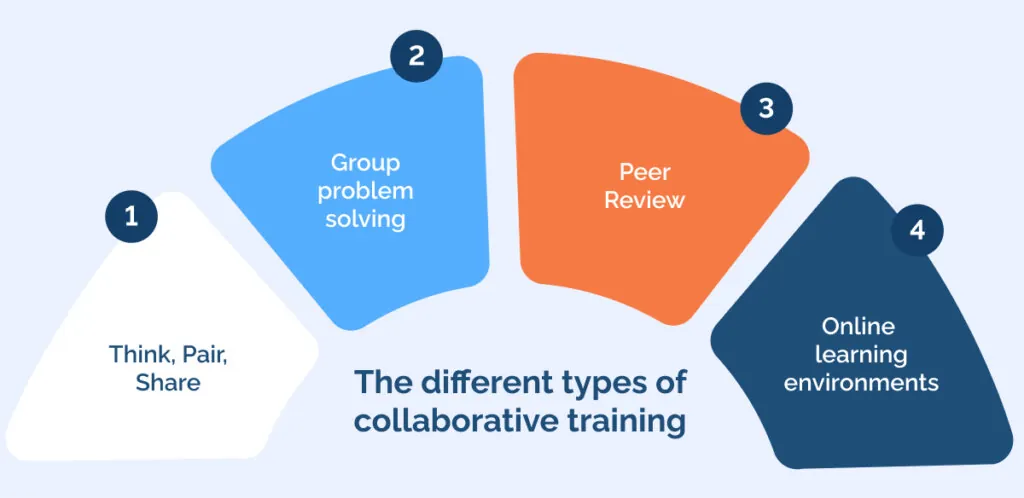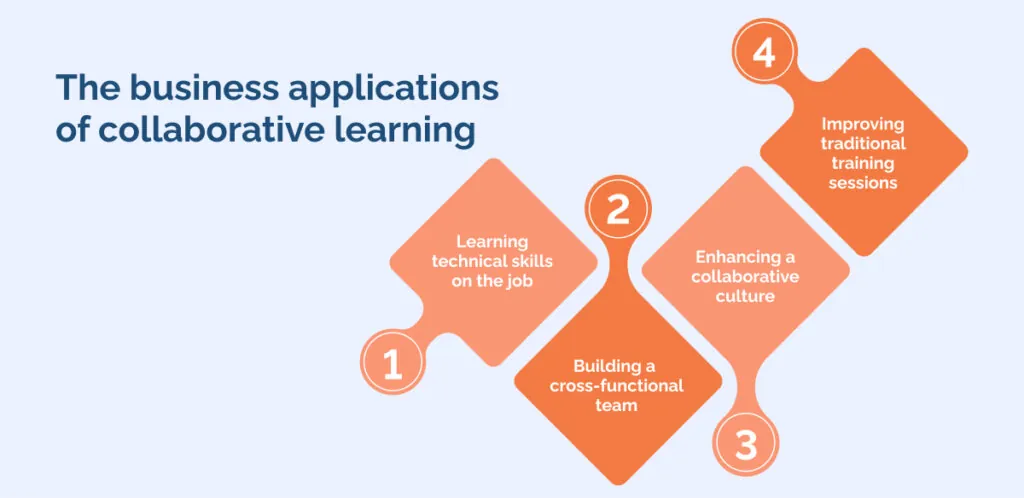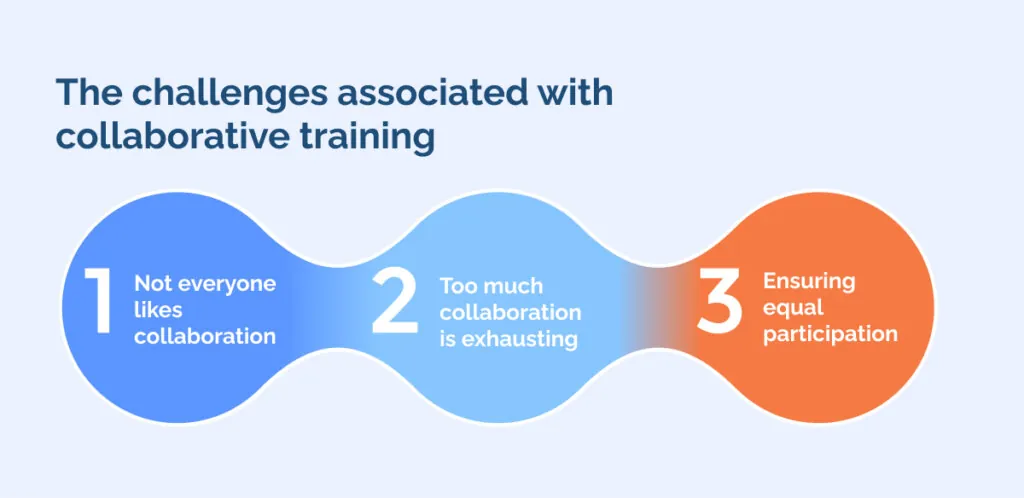
Collaborative training methods have a proven track record in business.
They are built on good foundations in educational theory. Collaborative learning leads to good learning outcomes, and comes with a range of fringe benefits – such as learner satisfaction, trainer wellbeing, and improvements in organizational culture. Moreover, collaborative training can be cheap and easy to implement.
As part of our series on employee training methods, this article will introduce the benefits of collaboration for staff training. It will:
- Define the meaning of collaborative training;
- Examine four different types of collaborative training intervention;
- Look at the business situations where collaborative training is especially effective;
- Go over the benefits and challenges of collaborative training.
Collaborative training can change your training in many positive ways, from enlivening old classrooms, to completing transforming your training provision. So it’s well worth your time and effort.
What is collaborative training?
Collaborative training methods emphasize group work, knowledge sharing, and joint problem-solving among learners. Whereas independent training models rely on individual learners to motivate themselves, collaborative training makes learners rely on the people around them.
Trainers choose collaborative methods when they want to improve learner engagement, enhance teamwork skills, and build a positive learning culture. However, collaborative training interventions support the fundamental goals of any educational work, such as knowledge retention, performance improvement, and upskilling.
Aspects of collaborative training have been around for millennia. However, it was only in the work of society educational theorist Lev Vygotsky that it was formalized, through his theory of proximal development. In 2024, collaborative training can still come as a surprise to learners – and that’s why you need to take care about implementing it.
Let’s take a broader look at what collaborative training can look like in an enterprise setting.
What are the different types of collaborative training?

Collaborative training methods take many forms.
A company that implements collaborative training principles might just be making a few tweaks to a workshop-style training session. But they could go as far as an enterprise-wide software package.
In this section, we’ll introduce four types of collaborative training – ranging from simple to complex. These include:
- Think, Pair, Share
- Group problem solving
- Peer Review
- Online learning environments
Think, Pair, Share
This is a simple technique that helps engage and encourage everyone in a training session. It’s especially valuable when you want learners to build trust in one another, think deeply about a problem, and make mistakes safely.
How to implement it
Trainers should strategically plan opportunities for its application rather than introducing it randomly. The technique should be aligned with the training objectives and seamlessly integrates with the overall session structure.
A “think, pair, share” moment follows this pattern:
- The trainer poses a question.
- For a short period of time, everyone shares their response with the person next to them.
- The trainer then chooses people at random to answer the question.
This technique helps build a sense of community – while giving the trainer valuable feedback about knowledge retention and understanding.
Tips for using it
If you’re planning to introduce this method, make sure you think about:
- “Think, Pair, Share” is simple, but it is not intuitive. Make sure you explain how to do it clearly.
- Commit to using it several times over until they get the idea of it.
- This is a great technique when you want to encourage everyone to play a role in the training session. If you know everyone is fully engaged, this might not be so valuable.
With a tiny bit of work, you can easily use Think, Pair, Share in your next training session.
Who is it for?
“Think, pair, share” works well in traditional didactic settings. It’s especially useful when you are conducting a training session in person. (Remote training sessions may need some extra care).
Group problem solving
Group problem-solving involves small teams working to analyze, discuss, and solve a particular problem. It’s widely used in various educational and professional settings to enhance critical thinking, teamwork, and problem-solving skills.
How to implement it
A good group problem-solving task should be set up carefully. Think about the following steps:
- Choose a relevant learning moment where it would work – don’t just use it because you want to!
- Create appropriate groups. The decisions might fall naturally if you are working with a specific business unit. But for cross-functional teams, it’s very important to get the right people together.
- Provide an appropriate level of instruction to help the groups solve the problem. You can introduce challenges by omitting some key information.
Tips for using it
You can’t rush a good group problem-solving task. So when you are planning your group task, think about the following points:
- Understand the Imaginary Scenario. If you’re setting up an imaginary scenario, ensure a thorough understanding of the problems presented. A clear grasp of the scenario enhances the exercise’s effectiveness.
- Relevance is Crucial. Ensure that the problem presented is relevant to the learning objectives. Relevance is key to preventing participants from viewing the exercise as a waste of time.
- Balance complexity and feasibility. Strike a balance between the complexity of the problem and its feasibility. In a training setting, tasks should be challenging yet solvable, acknowledging that real-life situations may not always be straightforward.
- Allocate time for reflection. Allow sufficient time for participants to reflect on the outcomes of the exercise. Reflection is essential for understanding the strengths and weaknesses each participant showed in the process.
Who is it for?
Group problem-solving can be useful in several circumstances.
First, you can use it as a team-building exercise in itself. In that case, it does not matter what information the team is talking about. So long as they are collaborating to produce an answer, they are in the right.
But group problem-solving is also valuable to prepare for real-life tasks in critical business areas. In a group problem-solving exercise, learners can work out how to make sense of fast-paced and difficult information, without the risks associated with the real-life problem.
(When your staff are working in especially critical roles, group problem solving may overlap with different forms of simulation training.
Peer Review
Peer review is used in professional settings to assess and improve the quality of work through evaluation by peers. It involves employees reviewing and providing feedback on the work of their colleagues or peers.
How to implement it
Take these steps to implement a peer review activity:
- First, identify a task or project in which this aspect of CPD will be especially important. Peer review might be a moment in a training exercise, but it could also be an element in a larger workflow.
- Secondly, find two peers who make an appropriate pairing. This method often works well if they are at a similar level of seniority and experience. They will have different knowledge that they can bring to the table, but they will also learn from the experience of reading their peers’ work.
- Finally, this method requires some supervision from an outside observer. They should join the reviewers for a reflection session.
Tips for using it
Peer review is a simple and low-risk method of training. Consider these tips when you’re starting out:
- Like many collaborative techniques, this might not work great on the first attempt – give it a go and see what happens! You will learn from the attempt.
- Part of the preparation could involve reflection on the most appropriate software for collaborating on a peer review task. Even if that’s just Google Docs, you should make sure your staff have got the tools they need to succeed.
Who is it for?
This technique is naturally suited for written or documentary tasks, such as producing a strategic plan, a sales presentation, or a content brief.
However, peer review can also work in more practical situations. For example, when staff members at different levels review each other’s performances in a warehouse situation.
Online learning environments
Software learning environments are designed for companies seeking to elevate their collaborative learning experiences. These environments often encompass adaptive learning platforms, training management systems, and Learning Management Systems (LMS). Digital Adoption Platforms may also be integrated into this system, providing a comprehensive approach to learning and development.
How to implement it
Implementing software learning environments is a substantial decision that requires careful consideration of organizational needs and goals. It involves selecting and integrating the appropriate platforms, ensuring seamless integration with existing processes.
Tips for using it
Here are some of the main things to consider when you’re introducing a learning management system (or other collaborative software):
- Prioritize user training and orientation to maximize the benefits of the software learning environment.
- Regularly update and customize the content to align with evolving learning objectives and organizational requirements.
- Foster a culture of continuous improvement, encouraging feedback and suggestions for enhancing the effectiveness of the learning environment.
Who is it for?
Software learning environments cater to a variety of use cases, making them suitable for broad applications. They are particularly beneficial for implementing company-wide solutions and establishing a foundation of useful materials for collaborative work.
The business applications of collaborative learning

The example of collaborative training intervention we’ve described above has countless practical applications for businesses. In this section, we’ll introduce four stand-out use cases that prove how valuable collaborative learning can be.
Learning technical skills on the job
Collaboration can help share niche technical skills.
This approach is obvious for technical skills around machinery or tasks. But it extends to any scenario involving specialized software or hardware. It embodies a “learning by doing” approach, emphasizing hands-on experience to bolster expertise
In a prime example, illustrated in a case study from HR Magazine, Anglian Water use collaborative learning to share knowledge and experience. It not only propels individuals to excel in their roles but also fosters a culture of knowledge-sharing, enabling skill expansion across the entire team.
Building a cross-functional team
Another business application of collaborative learning for creating cross-functional teams. A good cross-functional team requires a robust knowledge exchange and employing collaborative learning methodologies.
Collaborative learning serves as the linchpin, ensuring that knowledge is shared seamlessly across diverse skill sets. This approach not only enhances individual competencies but also cultivates a cohesive and collaborative atmosphere within the team, contributing to overall organizational agility and innovation.
Enhancing a collaborative culture
In the leading organizations of 2024, collaboration underpins everything they do. Collaborative learning can be the linchpin in developing a learning organization, breaking down the silo mentality, and adapting to the new challenges of the day.
As a 2019 HBR analysis explains, sustained collaboration is not just about policy: but requires skills such as listening, empathy, followership, and clarity in communications. Collaborative training exercises can be a great preparation for building all of these skills.
Improving traditional training sessions
For many organizations, it’s hard to escape the “traditional” training methods, involving instruction from one person at the front of the room. Simple collaborative training methods can be a valuable tool to elevate these scenarios. Activities such as “think, pair, share”, group work, and peer reviews can be seamlessly integrated into traditional settings.
What are the benefits of collaborative training?

Collaborative training techniques are a valuable tool for any trainer’s tool kit. And we’ve seen how collaborative training can take many forms, with a wide range of business applications. But collaborative training has several benefits over other methods and approaches. In this section, we’ll summarize some of the important positive dimensions of training collaboratively.
High-impact and low cost
The simplest collaborative methods can radically improve learner outcomes – even if they cost almost nothing to implement. Research from the UK’s EEF has made these qualities very clear.
Team building
The shared journey of collaborative training builds trust and rapport among team members. As they collaborate towards common goals, staff members learn about open communication, mutual support, and a deeper understanding of each team member’s strengths. So it’s no surprise that one of the most valuable by-products of collaborative training is the overall cohesiveness of the team.
Encourages individual responsibility
But as well as the team dynamic, collaborative working also leads to a more effective “interdependence” within a team. As a 2016 study from Dutch researchers shows, the members of the team recognize their own role in the process of working together. Each member of the work can learn to “pull their weight” much more effectively than with independent training methods.
Highly adaptable
Collaborative learning methods can be tailored to suit various learning styles, organizational needs, and industry-specific requirements. Whether through interactive discussions, group projects, or virtual collaborations, the flexibility inherent in collaborative training allows it to align seamlessly with diverse training objectives. This adaptability ensures that the training remains relevant and effective, catering to the dynamic nature of modern workplaces and accommodating different preferences and skill levels among participants.
Strong research base
With a strong research base behind collaborative training, learning and development leaders can implement collaborative strategies with peace of mind. The extensive literature in business publications, academic research, and philosophical tracts, all help justify the extensive training budget.
What are the challenges associated with collaborative training?

So far, we’ve mainly been looking at the positive aspects of collaborative training. But like any learning technique, collaborative methods have their downsides too.
Not everyone likes collaboration
Collaborative training methods don’t suit everyone. And, when UK researchers investigated the emotional responses students felt towards collaborative training, they found an almost equal split between positive and negative.
So, although collaborative training is an excellent tool to include in your repertoire, it should not be the only way you ask staff to learn. When it’s appropriate for employees to work independently, you can ease off from the collaboration once in a while.
Too much collaboration is exhausting
Moreover, remember that workers are often collaborating on many projects throughout their working lives. Research from the HBR warns that staff can experience collaborative overload. Even people who love collaborating need some spare time to do their thing.
Ensuring equal participation
Another challenge in collaborative training is ensuring equal participation among team members. Differing levels of engagement, expertise, or assertiveness can create imbalances within the group, hindering the collaborative process. Striking a harmonious dynamic where all participants contribute meaningfully requires careful facilitation and consideration of individual strengths and communication styles.
Collaborative training: thoughts for the future
In today’s businesses, there are many opportunities for collaborative training. But an explicit focus on collaboration can still make an impact, as big or as small as you want. Collaborative learning could radically change your organization’s training. However, it could also offer subtle improvements within traditional areas of instruction. Statista’s list of the most popular modes of delivering instruction does not include “collaboration”, but it’s clear that working together has a good place in blended learning, social learning, or old-fashioned instructor-led delivery.
WalkMe Team
WalkMe spearheaded the Digital Adoption Platform (DAP) for associations to use the maximum capacity of their advanced resources. Utilizing man-made consciousness, AI, and context-oriented direction, WalkMe adds a powerful UI layer to raise the computerized proficiency, everything being equal.



